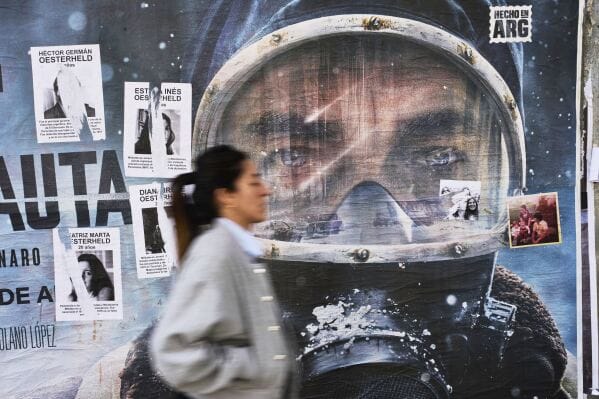Snow is rare in Buenos Aires. But when it fell on July 9th, 2007 Argentina’s Independence Day, people whispered: “aliens.” The correlation between snowfall and the end of the world is the chilling premise of El Eternauta (“The Eternaut”), the legendary Argentine graphic novel that has been reborn as a Netflix hit.
First published in 1957 by the magazine Hora Cero Semanal, this serialized comic strip changed Latin American science fiction forever. Created by Héctor Germán Oesterheld with artwork by Francisco Solano López, El Eternauta follows a group of Buenos Aires locals as they survive a mysterious snowfall—actually the first wave of an alien invasion.
After two failed attempts and a production stall due to COVID-19, in 2025 Netflix released an exciting adaptation directed by Bruno Stagnaro and starring acclaimed actor Ricardo Darín. The show quickly became the second most-watched series globally and the first most-watched non-English-language series. This great success followed other Latin American-made Netflix productions like One Hundred Years of Solitude and Pedro Páramo.
But its impact goes far beyond streaming stats—it tells a Latin American story of memory, trauma, and community that resonates with sci-fi fans worldwide.
What is The Eternaut about?
Although the graphic novel is set in 1950s Buenos Aires, the adaptation takes place in the present. The story follows Juan Salvo (portrayed by Darín), a father and war veteran who finds himself surrounded by deadly snow during a truco night (an iconic card game in Argentina that has strangely caught Japan’s attention). As chaos erupts, he joins forces with neighbors and strangers alike to find out what’s going on and to resist what turns out to be an alien invasion.
The show’s cast is a local powerhouse like no other. Ricardo Darín is considered a national idol and is the face of many critically-acclaimed Argentine films such as Nueve Reinas (2009), Oscar-nominated Relatos Salvajes (“Wild Tales”, 2014) and Argentina, 1985 (2022), plus Oscar-winner El secreto de tus ojos (“The Secret in Their Eyes”, 2009), which was later remade in the US with Julia Roberts and Nicole Kidman… though that remake is best remembered for how quickly it was forgotten.
Director Bruno Stagnaro is famous for coming up with heartfelt love letters to a struggling Buenos Aires like his film Pizza, birra, faso (1997) and the series Okupas (2000)—which portrays a group of squatters living in an abandoned house—available on Netflix as well.
Why El Eternauta matters for Latin American sci-fi
As we mentioned, El Eternauta first appeared in 1957. That’s six years before Doctor Who, nine years before Star Trek, and twenty years before Star Wars!
It’s considered the first major Spanish-language graphic novel. This is no surprise considering Oesterheld’s background. As a child, he had been marked by the adventure literature of writers such as Verne, Defoe, Melville, and Crusoe. Then, his degree in Geology helped him bring the scientific aspects of the plot alive.
As one of Latin America’s most important cultural hotspots, Argentina has always taken an interest in science fiction from an early time. For instance, the ahead-of-its-time publishing house Minotauro was one of the reasons this genre became legitimized literature in the Spanish-speaking world, with its translation of Ray Bradbury’s Martian Chronicles prologued by none other than Argentinian literary god Jorge Luis Borges.
But what’s most striking about The Eternaut is the symbolic gesture of placing a sci-fi narrative in a Third World nation, and how the alien invasion interacts not only with the local landscape but also with its inhabitants, who must rely on ingenuity to survive. Instead of the typical American city that sci-fi fans were used to seeing as the backdrop for such adventures, we get Buenos Aires. And the series fully embraces this local flavor, even including visual jokes, like a small replica of the Statue of Liberty, which really does exist in the neighborhood of Munro.
Instead of a superhero, the story’s hero is a group of ordinary people working together, the “collective hero,” as the author described it. It’s refreshing to see apocalyptic fiction in settings different from the usual US capitals.
The idea of Argentinians adapting science fiction is quite a challenge in itself due to budget restrictions and access to technology. That’s why it’s refreshing—and a valuable opportunity—when companies like Netflix choose to produce Latin American content and help it reach a wider audience.
The Eternaut and Its Link with Argentinian Politics
Beyond its gripping narrative, El Eternauta is steeped in Argentina’s complex history. Escaping from the last military coup that tormented the nation from 1976 to 1983, Oesterheld went underground, where he finished El Eternauta II. On April 27, 1977 he was kidnapped by the armed forces and became one of the 30,000 people who “disappeared” during the dictatorship. His four daughters were also kidnapped and murdered: Diana (24), Beatriz (19), Estela (25), and Marina (18). Two of them were pregnant; many stolen babies at the time are still being searched for today.
That’s why the collective hero is a crucial part of The Eternaut: people working together can face any challenges they come across. That’s the true message this sci-fi graphic novel (and now series) conveys.
By updating the story to today’s context, Stagnaro also wanted to address another dark topic from Argentina’s history: the Malvinas War. In 1982, the regime seized the Islas Malvinas in an attempt to rekindle nationalism and divert attention from the domestic political disaster. However, the United Kingdom retook the islands after 74 days, a war that took many lives from both sides. The decision to use the word Malvinas instead of “Falklands” (even in the English subtitles) is a way of addressing postcolonial tensions and a claim that’s still alive to this day.
The Eternaut’s Political Legacy
Regardless of the fact that The Eternaut was never censored by the military junta, it became the subject of controversy during the twenty-first century. Around 2009, Peronist political groups linked to then-President Nestor Kirchner chose The Eternaut’s main character, Juan Salvo, as their symbol and merged these two figures together to make “El Nestornauta”. Even though Oesterheld wasn’t associated with the figure of Perón, this new symbol tried to embody the collective hero the graphic novel described.
A few years later, former President Mauricio Macri took a different route and decided to cut The Eternaut from the public schools’ curriculum due to alleged “indoctrination”. As expected, this backfired with a rise in the graphic novel’s sales. This comes to show that although more than 50 years have gone by since the publishing of The Eternaut, its message lives on.
Latinas to The Front: New Story, Same Message
Netflix’s adaptation surprised all Argentinians by updating the story for today’s viewers. First of all, it gave women a more important role in the plot, as we can see with the characters of Elena (played by Carla Peterson), Ana, and Clara. The show also added an important figure in Buenos Aires’ current demographics: Inga, a Venezuelan immigrant who worked as a delivery person for a multinational company. Her role embodies modern Latin American migration.

“The truth is I couldn't tell you for sure [why they included a Venezuelan character], but considering that the series updates the essence of what the comic book is, I think it has to do with that. Today, there are many Venezuelans who are here in your beautiful country, and I think it has more to do with that than anything else”, said actress Orianna Cárdenas (Inga) in an interview with Infobae.
This attention to detail and courage to adapt such an emblematic graphic novel helps bring the story to life and showcase Argentina’s current reality, something that director Stagnaro simply loves to do.
The Eternaut is more than just a sci-fi series. It’s a story of community over individualism.
If you are a sci-fi fan who wants to learn more about Latin American history, what better way of doing so than exploring some local cultural productions? Of course you don’t need to know Argentina’s history to connect with the show, but knowing its backdrop makes its message all the more powerful.
And remember: nadie se salva solo (“no one survives alone”).

Resumen en español
El Eternauta, la histórica novela gráfica argentina, resurge como una exitosa serie de Netflix dirigida por Bruno Stagnaro y protagonizada por Ricardo Darín. La historia, que mezcla ciencia ficción con crítica social, sigue a un grupo de vecinos de Buenos Aires que enfrentan una invasión alienígena oculta tras una nevada mortal. Más que una aventura apocalíptica, es una metáfora del trabajo colectivo, la memoria y la resistencia. La serie actualiza la trama al presente, incorpora diversidad y refleja tensiones políticas pasadas y presentes. Con gran impacto internacional, El Eternauta demuestra que la ciencia ficción también puede contar historias profundamente latinoamericanas.






